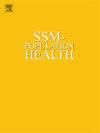Does regular engagement with arts and creative activities improve adolescent mental health and wellbeing? A systematic review and assessment of causality
IF 3.1
2区 医学
Q1 PUBLIC, ENVIRONMENTAL & OCCUPATIONAL HEALTH
引用次数: 0
Abstract
Background
There is a growing body of evidence on the relationship between arts and creative activities and adolescent mental health and wellbeing. However, most research has focused on short, sharp creative arts interventions, and not on regular, day-to-day engagement with arts and creative activities. It is unclear the extent to which this complex relationship can be considered causal. This systematic review aimed to summarise the quantitative evidence on engagement with arts and creative activities and assess whether it supports causal conclusions.
Methods
We systematically searched 10 databases. We included any quantitative studies (cross-sectional and longitudinal observational studies, natural and quasi-experimental designs, and controlled trials) assessing the link between regular engagement (multiple instances over a period of more than one week) with arts and creative activities, and adolescent (10-19y) mental health and wellbeing. We included studies published in English from 2014 to 2024. Methodological quality was assessed using JBI critical appraisal tools. Support for causal conclusions was assessed using the Bradford Hill Viewpoints.
Results
Of 7769 records screened, 28 were selected for inclusion. Most studies suggested a positive association between arts engagement and adolescent mental health and wellbeing. We found some support for all Bradford Hill viewpoints, but less support for experimental evidence and a dose-response relationship.
Discussion
This review provides moderate support for a causal relationship between arts engagement and adolescent mental health and wellbeing. More evidence from randomised experiments or generated by applying causal inference methods to observational data is needed to better account for selection, confounding, and reverse-causality.
经常参加艺术和创造性活动能改善青少年的心理健康和幸福吗?对因果关系的系统回顾和评估
越来越多的证据表明,艺术和创造性活动与青少年心理健康和幸福之间存在关系。然而,大多数研究都集中在短期的、尖锐的创造性艺术干预上,而不是定期的、日常的艺术和创造性活动。目前尚不清楚这种复杂的关系在多大程度上可以被认为是因果关系。本系统综述旨在总结参与艺术和创造性活动的定量证据,并评估其是否支持因果结论。方法系统检索10个数据库。我们纳入了所有定量研究(横断面和纵向观察研究、自然和准实验设计以及对照试验),以评估定期参与(超过一周的时间内多次参与)艺术和创造性活动与青少年(10-19岁)心理健康和福祉之间的联系。我们纳入了2014年至2024年用英语发表的研究。使用JBI关键评估工具评估方法学质量。对因果结论的支持使用布拉德福德希尔观点进行了评估。结果从筛选的7769条记录中筛选出28条纳入。大多数研究表明,参与艺术与青少年心理健康和幸福之间存在积极联系。我们发现对布拉德福德·希尔的所有观点都有一些支持,但对实验证据和剂量-反应关系的支持较少。本综述为艺术参与与青少年心理健康和幸福之间的因果关系提供了适度的支持。需要更多来自随机实验或通过对观测数据应用因果推理方法产生的证据来更好地解释选择、混淆和反向因果关系。
本文章由计算机程序翻译,如有差异,请以英文原文为准。
求助全文
约1分钟内获得全文
求助全文
来源期刊

Ssm-Population Health
PUBLIC, ENVIRONMENTAL & OCCUPATIONAL HEALTH-
CiteScore
6.50
自引率
2.10%
发文量
298
审稿时长
101 days
期刊介绍:
SSM - Population Health. The new online only, open access, peer reviewed journal in all areas relating Social Science research to population health. SSM - Population Health shares the same Editors-in Chief and general approach to manuscripts as its sister journal, Social Science & Medicine. The journal takes a broad approach to the field especially welcoming interdisciplinary papers from across the Social Sciences and allied areas. SSM - Population Health offers an alternative outlet for work which might not be considered, or is classed as ''out of scope'' elsewhere, and prioritizes fast peer review and publication to the benefit of authors and readers. The journal welcomes all types of paper from traditional primary research articles, replication studies, short communications, methodological studies, instrument validation, opinion pieces, literature reviews, etc. SSM - Population Health also offers the opportunity to publish special issues or sections to reflect current interest and research in topical or developing areas. The journal fully supports authors wanting to present their research in an innovative fashion though the use of multimedia formats.
 求助内容:
求助内容: 应助结果提醒方式:
应助结果提醒方式:


